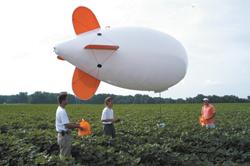
If you're looking for a way to monitor your crops from above, you might be interested in using a blimp fitted with a digital camera.
That's what University of Georgia researchers Glen Ritchie and Craig Bednarz did when they wanted to find an inexpensive and easy way to decide when to irrigate a cotton field.
"The photos clearly showed washed out areas of water stress and told us when to irrigate before drought set in," he says.
"With a blimp, we could go out and take our measurements without having to schedule a pilot to fly over. It was something we could put in the shop, grab when we needed, run out and take the measurements," Ritchie says.
Although they spent a chunk of money to create the system, Ritchie says you could do it for a lot less. "You can pick up a lot of the equipment at Wal-Mart."
They bought the 15-ft. long helium tethered blimp kit through Southern Balloon Works Inc.
"The nice thing about it was that they gave us an idea of the amount of lift each of their blimps has and we selected one with a lift of between 5 and 10 lbs.," Ritchie says. "You can get smaller blimps for a lot less money but then you'd need to find a smaller camera."
They bought two Nikon 4300 digital cameras and fitted them with electronic shutters so that a handler can operate them from the ground with a remote transmitter. They took one camera apart and modified it for infrared photos. "We rarely use it though," he says.
A gondola under the balloon holds the cameras in place.
Ritchie admits he didn't have much electrical knowledge but was able to put everything together.
"One of the things we were concerned about was the string," he says. "It was 1,000 ft. long and had 110 lbs. of tensile strength but was only twice as thick as a yoyo string. But we haven't had any problems with it breaking or coming undone."
In order to avoid problems with the FAA, they can only run it up to about 300 ft. "You can ask for special permission and usually, they'll let you run it up a quarter mile or 2,000 ft. which is good enough to see over center pivots. It's never going to replace an airplane but for something up to 70 acres, it works pretty good," Ritchie says.
It takes a full helium tank to fill the blimp.
